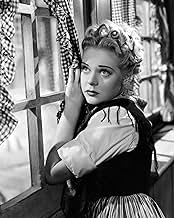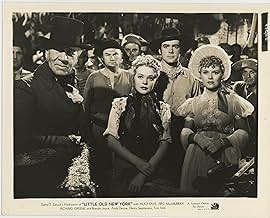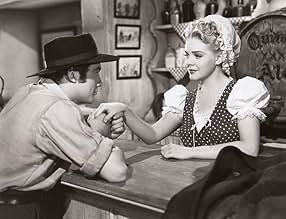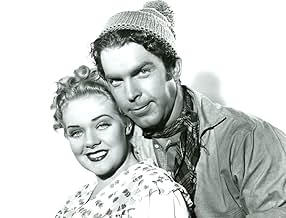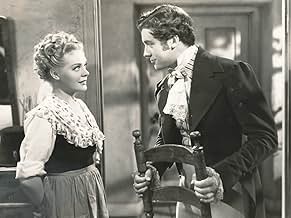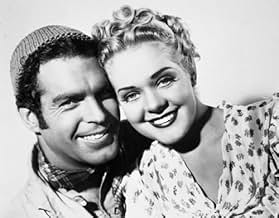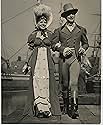Füge eine Handlung in deiner Sprache hinzuSteamboat inventor Robert Fulton shows up in New York in 1807. Tavern keeper Pat O'Day believes in him, but her boyfriend doesn't. All seems lost after sailors, afraid of losing their jobs, ... Alles lesenSteamboat inventor Robert Fulton shows up in New York in 1807. Tavern keeper Pat O'Day believes in him, but her boyfriend doesn't. All seems lost after sailors, afraid of losing their jobs, burn his boat.Steamboat inventor Robert Fulton shows up in New York in 1807. Tavern keeper Pat O'Day believes in him, but her boyfriend doesn't. All seems lost after sailors, afraid of losing their jobs, burn his boat.
- Regie
- Drehbuch
- Hauptbesetzung
Clarence Wilson
- Willie Stout
- (as Clarence Hummel Wilson)
Theodore von Eltz
- Washington Irving
- (as Theodore Von Eltz)
Oscar 'Dutch' Hendrian
- Blackie
- (as O.G. Hendrian)
Empfohlene Bewertungen
"Little Old New York" is a fictional story about Robert Fulton's invention of the first successful steamboat. It is based on a 1920 Broadway play by Rida Young of the same title that ran for 308 performances. Young was a playwright who became best known for her lyrics to Victor Herbert's operetta, "Naughty Marietta."
Fulton had been living in Europe for some 20 years where he first made a living as a painter and then began working on inventions, sometimes with others. Back in the States, Fulton set out to find backing to build the first steamboat to navigate rivers. Henry Stephenson plays Robert Livingston, a former U.S. ambassador whom Fulton had met and befriended in England. Livingston helped raise the funds for Fulton's steamboat.
Richard Green plays Robert Fulton, and while the story is about his invention, it revolves mostly around another couple. Much, if not most of this is fictional, of course. Alice Faye plays Pat O'Day, a wharf front tavern owner who first is smitten by Fulton, and then helps round up support and finances for him. Her cohort in this adventure is Charles Brownne, played by Fred MacMurray. He's been Pat's beau all along.
This is a light comedy and drama about Fulton's invention. It does have some historical value, but mostly in its pictorial presentation of the docks and shipbuilding of 18th and 19th centuries, The Fox studio did a superb job in replicating the shipbuilding works of New England of the day. And in portraying the craft of shipbuilding at the time.
Fulton had been living in Europe for some 20 years where he first made a living as a painter and then began working on inventions, sometimes with others. Back in the States, Fulton set out to find backing to build the first steamboat to navigate rivers. Henry Stephenson plays Robert Livingston, a former U.S. ambassador whom Fulton had met and befriended in England. Livingston helped raise the funds for Fulton's steamboat.
Richard Green plays Robert Fulton, and while the story is about his invention, it revolves mostly around another couple. Much, if not most of this is fictional, of course. Alice Faye plays Pat O'Day, a wharf front tavern owner who first is smitten by Fulton, and then helps round up support and finances for him. Her cohort in this adventure is Charles Brownne, played by Fred MacMurray. He's been Pat's beau all along.
This is a light comedy and drama about Fulton's invention. It does have some historical value, but mostly in its pictorial presentation of the docks and shipbuilding of 18th and 19th centuries, The Fox studio did a superb job in replicating the shipbuilding works of New England of the day. And in portraying the craft of shipbuilding at the time.
This is an incredibly fictionalized account of the work of Robert Fulton to make the first American steamship. Alice Faye, Fred MacMurray and Ward Bond are there...even though they really were inventions of the playwright to first came up with this story. As a history lesson, it comes up lacking! What follows is sort of a comic book version of history--the sort of thing that Hollywood often did in their highly fictionalize 'true stories'.
So is this any good? Well, it looks nice. Twentieth Century-Fox made lovely looking films and the music and glitz are all present in this expensive production. It's also mildly entertaining...but slight. No great drama or comedy here...just another highly fictionalized film along the same lines as "In Old Chicago" and nothing more.
So is this any good? Well, it looks nice. Twentieth Century-Fox made lovely looking films and the music and glitz are all present in this expensive production. It's also mildly entertaining...but slight. No great drama or comedy here...just another highly fictionalized film along the same lines as "In Old Chicago" and nothing more.
Nothing deep, but an interesting Hollywood-ized account of the development of steam propeled ships. Imagine... being able to propel a vessel upstream even into the wind! But at what risk? The current economy's support? And how do you pay for the thing?!?! Additionally, you have a young country out to protect its interests... but what if it acted Isolationistically? Would you be able to pursue your dreams? If the overdeveloped subplots of "Sink the Bismark" did'nt offend your sensibilities greatly, you will enjoy this yarn.
Robert Fulton after trying and failing to develop a ship powered by a steam engine is having trouble getting some new backing. A prototype vessel blew up on the River Seine as he was trying to impress Napoleon Bonaparte with steam's potential. Now he's back in Little Old New York trying to sell the idea to the movers and shakers of his day.
Richard Greene plays the idealistic and gentlemanly Fulton. But the only two converts he makes are his landlady, tavern owner Alice Faye and Fred MacMurray, who works for Ward Bond at a shipyard. But after Fulton beats bully boy Bond in a fight, MacMurray loses his job. But Fred starts his own shipyard and his first client will be Fulton if he can raise the money.
Little Old New York had the story of Robert Fulton grafted on to a play by Rida Johnson Young of the same name that was the basis for the film. There's no mention that in real life Fulton was as handy with his dukes as he is in this film. It is true he married the niece of Chancellor Robert Livingston played by Brenda Joyce and Livingston did finally sell some of his friends like Nicholas Roosevelt, John Jacob Astor, and Washington Irving to finally back Fulton's steamboat.
Livingston is played by one of my favorite character actors Henry Stephenson who always brings a touch of old world class to all his roles. Livingston's title of Chancellor stems from the fact the chief judicial officer of New York had that title, a carryover from colonial days. Among other things Livingston did was swear in George Washington to his first term as president. There was no Supreme Court yet because Washington hadn't appointed anyone yet.
Little Old New York probably was seen by Darryl Zanuck as a fitting sequel to In Old Chicago which was Alice Faye's first period costume film. The parts that Fred MacMurray and Richard Greene have are those that would normally have been played by Tyrone Power and Don Ameche. In fact I could see both of those guys playing either of the MacMurray or Greene parts.
If Little Old New York is not the real story of Robert Fulton it certainly is a nice bit of entertainment served up by a fine cast at the direction of Henry King.
Richard Greene plays the idealistic and gentlemanly Fulton. But the only two converts he makes are his landlady, tavern owner Alice Faye and Fred MacMurray, who works for Ward Bond at a shipyard. But after Fulton beats bully boy Bond in a fight, MacMurray loses his job. But Fred starts his own shipyard and his first client will be Fulton if he can raise the money.
Little Old New York had the story of Robert Fulton grafted on to a play by Rida Johnson Young of the same name that was the basis for the film. There's no mention that in real life Fulton was as handy with his dukes as he is in this film. It is true he married the niece of Chancellor Robert Livingston played by Brenda Joyce and Livingston did finally sell some of his friends like Nicholas Roosevelt, John Jacob Astor, and Washington Irving to finally back Fulton's steamboat.
Livingston is played by one of my favorite character actors Henry Stephenson who always brings a touch of old world class to all his roles. Livingston's title of Chancellor stems from the fact the chief judicial officer of New York had that title, a carryover from colonial days. Among other things Livingston did was swear in George Washington to his first term as president. There was no Supreme Court yet because Washington hadn't appointed anyone yet.
Little Old New York probably was seen by Darryl Zanuck as a fitting sequel to In Old Chicago which was Alice Faye's first period costume film. The parts that Fred MacMurray and Richard Greene have are those that would normally have been played by Tyrone Power and Don Ameche. In fact I could see both of those guys playing either of the MacMurray or Greene parts.
If Little Old New York is not the real story of Robert Fulton it certainly is a nice bit of entertainment served up by a fine cast at the direction of Henry King.
I only saw this film in the 1960s, and memories of it are somewhat sparse. I recall Richard Greene trying to get financing for his steamboat, and finding roadblocks by various troublemakers, mostly local sailors who realize that steam power will hurt their sail oriented business. One moment that was well handled is the burning of the original "Claremont" (the actual name of the boat was "the North River Steamboat of Claremont" - Claremont was the name of the country estate of Chancellor Robert Livingston, Fulton's backer and brother-in-law). Another moment of the film was Greene's confusing meeting with Victor Killian, introduced to him as "Mr. DeWitt" (Greene thinks it's DeWitt Clinton - Killian is actually a thug trying to create a scene in which Greene can be beaten up). Alice Faye is given a song or two to sing, and is the love interest of MacMurray (who is also momentarily jealous of Greene, but still supports the steamboat at the end).
If one is really interested in the story of this invention - our first really important invention in the industrial revolution - read James Flexner's "Steamboats Come True". The actual first inventor was John Fitch, who made a successful steamboat that ran to and from Philadelphia in 1790 - 1792). Fitch was clever, but he did not know how to make a plan of the invention that could enable him to rebuild a second working steamboat. It was a hit or miss thing with Fitch. In 1798 he committed suicide in Kentucky. Besides Fitch there were other inventors (Oliver Evans, James Rumsey), but Fulton had engineering training, and was able to make patents that could be followed to repeat his invention again and again. So 1807 is the year we usually credit for the invention of the steamboat.
Yet oddly enough this is the only sound film of Fulton's invention that was made in Hollywood. I suspect it is because the Claremont was a prototype that lacked the glamor of later vessels (those that plied the Mississippi River from 1828 - 1900), and that (with a few tourist exceptions) no longer matters to us. More films dealing with railway and car transportation have been made - even more about aviation and submarines. So I suspect there will never be a more solid look at Fulton's career as artist, submarine pioneer, and steamboat developer. There is another film where Fulton pops up: "Austerlitz", a French film made in the 1950s where Orson Welles appeared as Fulton trying (in 1804-05) to interest Napoleon I in his submarine. That's about it. Maybe one day a serious film on Fulton will be made. Until then we have "Little Old New York".
If one is really interested in the story of this invention - our first really important invention in the industrial revolution - read James Flexner's "Steamboats Come True". The actual first inventor was John Fitch, who made a successful steamboat that ran to and from Philadelphia in 1790 - 1792). Fitch was clever, but he did not know how to make a plan of the invention that could enable him to rebuild a second working steamboat. It was a hit or miss thing with Fitch. In 1798 he committed suicide in Kentucky. Besides Fitch there were other inventors (Oliver Evans, James Rumsey), but Fulton had engineering training, and was able to make patents that could be followed to repeat his invention again and again. So 1807 is the year we usually credit for the invention of the steamboat.
Yet oddly enough this is the only sound film of Fulton's invention that was made in Hollywood. I suspect it is because the Claremont was a prototype that lacked the glamor of later vessels (those that plied the Mississippi River from 1828 - 1900), and that (with a few tourist exceptions) no longer matters to us. More films dealing with railway and car transportation have been made - even more about aviation and submarines. So I suspect there will never be a more solid look at Fulton's career as artist, submarine pioneer, and steamboat developer. There is another film where Fulton pops up: "Austerlitz", a French film made in the 1950s where Orson Welles appeared as Fulton trying (in 1804-05) to interest Napoleon I in his submarine. That's about it. Maybe one day a serious film on Fulton will be made. Until then we have "Little Old New York".
Wusstest du schon
- WissenswertesThe play opened on Broadway in New York City, New York, USA on 8 September 1920 and closed in June 1921 after 303 performances. The opening night cast included Genevieve Tobin as Pat O'Day, Douglas Wood, as Cornelius Vanderbuilt and Donald Meek.
- PatzerThe hairstyles of the women are from the time the film was made, not from the early 1800s.
- VerbindungenReferenced in Star Dust (1940)
- SoundtracksWho Is the Beau of the Belle Of New York
(1940) (uncredited)
Music and Lyrics by Mack Gordon
Performed by Tyler Brooke and joined by Alice Faye and other dancing patrons of Krausmeyer's Pavillion
Top-Auswahl
Melde dich zum Bewerten an und greife auf die Watchlist für personalisierte Empfehlungen zu.
Details
- Erscheinungsdatum
- Herkunftsland
- Sprache
- Auch bekannt als
- Hertiginnan från hamnkvarteret
- Drehorte
- Produktionsfirma
- Weitere beteiligte Unternehmen bei IMDbPro anzeigen
- Laufzeit1 Stunde 40 Minuten
- Farbe
- Seitenverhältnis
- 1.37 : 1
Zu dieser Seite beitragen
Bearbeitung vorschlagen oder fehlenden Inhalt hinzufügen

Oberste Lücke
By what name was Little Old New York (1940) officially released in India in English?
Antwort
